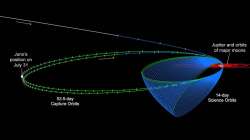NASA's Juno all set to reach the most distant point in its orbit of Jupiter
Five years after departing from Earth, and month after slipping into orbit around Jupiter, NASA’s Juno spacecraft is all set to reach the farthest point in its orbit for the first time on Sunday. The

Five years after departing from Earth, and month after slipping into orbit around Jupiter, NASA’s Juno spacecraft is all set to reach the farthest point in its orbit for the first time on Sunday.
The orbit, known as “apojove”is nearly 8.1 million km from Jupiter, and after this point the gravitational grip of solar system’s largest planet on Juno will cause the spacecraft to begin falling back toward it for another pass.
“For five years we have been focussed on getting to Jupiter. Now we are there, and we are concentrating on beginning dozens of flybys of Jupiter to get the science we are after,” said Scott Bolton, Juno’s Principal Investigator at the Southwest Research Institute in San Antonio.
Launched on August 5, 2011, Juno took a long, looping path around the inner solar system to set up an Earth flyby, in which our planet’s gravity flung the spinning probe onward toward Jupiter.
Juno arrived at Jupiter on July 4 and is currently executing the first of two long orbits prior to beginning its science mission.

The spacecraft’s science instruments were turned off during orbit insertion to simplify spacecraft operations during the flawless manoeuvre that allowed Jupiter’s gravity to capture Juno into orbit.
Following the capture of orbits, Juno will fire its engine once more to shorten its orbital period to 14 days and begin its science mission.
But before that happens, on August 27, Juno must finish its first lap around Jupiter, with a finish line that represents the mission’s closest pass over the gas giant. During the encounter, Juno will skim past Jupiter at a mere 4,200 km above the cloud tops.
(With Agency input)
